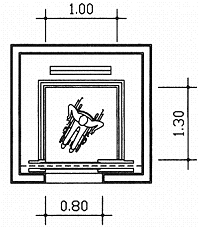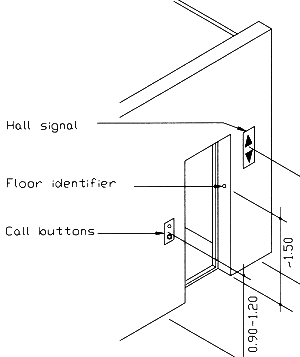I was looking around to find the appropriate dimensions for elevators to suit wheelchair users, and I found this article by: United Nations System and Persons with Disabilities.
First: Identifying the problems that might face wheelchair users:1- Inadequate space inside the elevator cab.
2- High position of switches, buttons and control panel.
3- Narrow entry doors.
4- Insufficient opening time interval.
provide well-dimensioned elevators, that can be used conveniently.
Third: Design considerations:
3.1 General
 The accessible elevator should serve all floors normally reached by the public.
The accessible elevator should serve all floors normally reached by the public. Key-operated elevators should be used only in private facilities or when an elevator operator is present.
Key-operated elevators should be used only in private facilities or when an elevator operator is present. Wide elevator cabs are preferable to long ones.
Wide elevator cabs are preferable to long ones.3.2 Elevator cab
 The minimum internal elevator dimensions, allowing for one wheelchair passenger alone, are 1.00 m x 1.30 m (fig. 1).
The minimum internal elevator dimensions, allowing for one wheelchair passenger alone, are 1.00 m x 1.30 m (fig. 1). The door opening should not be less than 0.80 m.
The door opening should not be less than 0.80 m. The inside of the elevator should have a handrail on three sides located on 0.80 to 0.85 m from the floor (fig. 2).
The inside of the elevator should have a handrail on three sides located on 0.80 to 0.85 m from the floor (fig. 2). The maximum tolerance for stop precision should be 20 mm.
The maximum tolerance for stop precision should be 20 mm.3.3 Control panel
 The control panel can be mounted at one of the alternative locations shown in fig. 3.
The control panel can be mounted at one of the alternative locations shown in fig. 3. For ease of reach, the control panel should be mounted 0.90 m to 1.20 m from the floor (fig. 2).
For ease of reach, the control panel should be mounted 0.90 m to 1.20 m from the floor (fig. 2). Control buttons should be in an accessible location and illuminated. Their diameter should be no smaller than 20 mm.
Control buttons should be in an accessible location and illuminated. Their diameter should be no smaller than 20 mm. The numerals on the floor selector buttons should be embossed so as to be easily identifiable by touch.
The numerals on the floor selector buttons should be embossed so as to be easily identifiable by touch.
3.4 Call buttons
 For ease of reach, call buttons should be mounted 0.90 m to 1.20 m from the floor (fig. 4). 3.5 Floor identifiers
For ease of reach, call buttons should be mounted 0.90 m to 1.20 m from the floor (fig. 4). 3.5 Floor identifiers
 Tactile numerals should be placed on both sides of the door jambs at an approximate height of 1.50 m to help a lone sightless passenger to identify the floor reached (fig. 4). 3.6 Hall signal
Tactile numerals should be placed on both sides of the door jambs at an approximate height of 1.50 m to help a lone sightless passenger to identify the floor reached (fig. 4). 3.6 Hall signal
 The elevator hall signal should be placed at an approximate height of 1.80 m (fig. 4).
The elevator hall signal should be placed at an approximate height of 1.80 m (fig. 4).
3.7 Door re-opening activators
 The door opening interval should be no less than five seconds. Re-opening activators should be provided.
The door opening interval should be no less than five seconds. Re-opening activators should be provided.
3.8 Audiovisual signals
 The elevator should signal arrival at each floor by means of a bell and a light to alert sightless and hearing-impaired passengers simultaneously.
The elevator should signal arrival at each floor by means of a bell and a light to alert sightless and hearing-impaired passengers simultaneously.
3.9 Floor surface
 The floor of the elevator and the area in front of the elevetor on each floor should have a non skid resilient surface or a low-pile fixed carpet.
The floor of the elevator and the area in front of the elevetor on each floor should have a non skid resilient surface or a low-pile fixed carpet.
3.10 Colour
 The colour of the door should contrast with the surrounding surface so as to be easily distinguishable by persons with visual impairments.
The colour of the door should contrast with the surrounding surface so as to be easily distinguishable by persons with visual impairments.
Source: http://www.un.org/esa/socdev/enable/designm/AD2-02.htm
 For ease of reach, call buttons should be mounted 0.90 m to 1.20 m from the floor (fig. 4). 3.5 Floor identifiers
For ease of reach, call buttons should be mounted 0.90 m to 1.20 m from the floor (fig. 4). 3.5 Floor identifiers Tactile numerals should be placed on both sides of the door jambs at an approximate height of 1.50 m to help a lone sightless passenger to identify the floor reached (fig. 4). 3.6 Hall signal
Tactile numerals should be placed on both sides of the door jambs at an approximate height of 1.50 m to help a lone sightless passenger to identify the floor reached (fig. 4). 3.6 Hall signal The elevator hall signal should be placed at an approximate height of 1.80 m (fig. 4).
The elevator hall signal should be placed at an approximate height of 1.80 m (fig. 4).3.7 Door re-opening activators
 The door opening interval should be no less than five seconds. Re-opening activators should be provided.
The door opening interval should be no less than five seconds. Re-opening activators should be provided.3.8 Audiovisual signals
 The elevator should signal arrival at each floor by means of a bell and a light to alert sightless and hearing-impaired passengers simultaneously.
The elevator should signal arrival at each floor by means of a bell and a light to alert sightless and hearing-impaired passengers simultaneously.3.9 Floor surface
 The floor of the elevator and the area in front of the elevetor on each floor should have a non skid resilient surface or a low-pile fixed carpet.
The floor of the elevator and the area in front of the elevetor on each floor should have a non skid resilient surface or a low-pile fixed carpet.3.10 Colour
 The colour of the door should contrast with the surrounding surface so as to be easily distinguishable by persons with visual impairments.
The colour of the door should contrast with the surrounding surface so as to be easily distinguishable by persons with visual impairments.Source: http://www.un.org/esa/socdev/enable/designm/AD2-02.htm





No comments:
Post a Comment